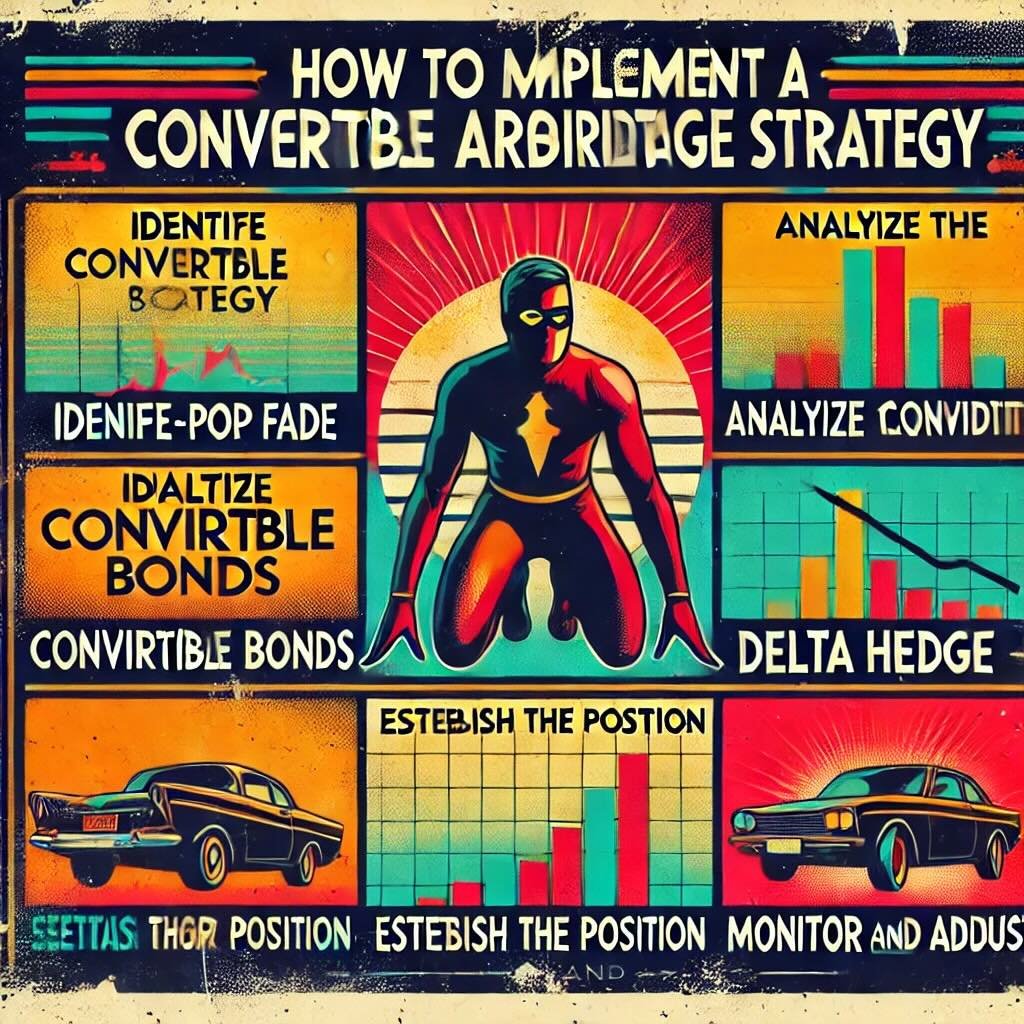Imagine combining the stability of bonds with the upside potential of stocks. That’s the essence of convertible arbitrage—a sophisticated investment strategy that capitalizes on price inefficiencies between a company’s convertible bonds and its underlying stock. Convertible arbitrage involves buying convertible bonds (which can be converted into a predetermined number of shares of the issuing company) and simultaneously shorting the underlying stock. The goal is to profit from the pricing differences between these two securities, regardless of market direction.
source: Calamos on YouTube
Overview Of Convertible Arbitrage

So, why should you care about convertible arbitrage? This article aims to demystify this complex strategy, breaking it down into easy-to-understand steps. Whether you’re a seasoned investor looking to diversify your portfolio or a curious beginner wanting to explore advanced strategies, we’ll guide you through the essentials of implementing convertible arbitrage. We’ll cover the basics, benefits, and potential pitfalls, providing practical examples to illustrate how it all works. Ready to dive into the world of convertible arbitrage? Let’s get started!

Understanding Convertible Arbitrage
Definition
Convertible arbitrage is an investment strategy that takes advantage of the price differences between a company’s convertible bonds and its underlying stock. Here’s how it works: you buy a convertible bond, which is a type of bond that can be converted into a certain number of the company’s shares. At the same time, you short the company’s stock. The idea is to profit from the mispricing between the bond and the stock, regardless of whether the stock price goes up or down. It’s a market-neutral strategy, meaning it aims to make money in both rising and falling markets.
Components
There are two main components in a convertible arbitrage strategy:
- Convertible Bonds: These are bonds that can be converted into a fixed number of shares of the issuing company. Convertible bonds offer the safety of fixed-income securities, along with the upside potential of stocks. They pay interest like regular bonds but also give you the option to convert them into shares if the company’s stock performs well.
- Short Position in the Underlying Stock: To hedge against the stock’s movements, you simultaneously short the same company’s stock. Short selling involves borrowing shares and selling them with the hope of buying them back at a lower price. This short position helps offset any potential losses if the stock price declines.
Market Inefficiencies
Convertible arbitrage exploits market inefficiencies that arise from the mispricing of convertible bonds and the underlying stock. These inefficiencies can occur due to various reasons:
- Volatility Mispricing: The market might undervalue or overvalue the volatility of the stock, leading to mispricing in the convertible bond.
- Interest Rate Changes: Fluctuations in interest rates can affect the price of convertible bonds differently than the underlying stock.
- Corporate Actions: Events like mergers, acquisitions, or dividend announcements can create temporary inefficiencies.
By carefully analyzing these factors, convertible arbitrageurs seek to profit from the price discrepancies between the convertible bond and the stock. They use sophisticated mathematical models and real-time data to identify and exploit these opportunities.

Benefits of Convertible Arbitrage
Risk Management
Convertible arbitrage is a savvy way to manage and mitigate risk in your investment portfolio. By buying convertible bonds and shorting the underlying stock, you create a hedge that protects you from major price swings in either direction. Think of it as having a safety net under your tightrope walk. If the stock price drops, your short position gains value, offsetting the loss in the bond’s value. If the stock price rises, the bond’s conversion feature kicks in, letting you convert to equity and profit from the upside. This hedging strategy helps cushion your portfolio against volatility and market downturns, offering a smoother ride through turbulent times.
Potential Returns
One of the most attractive aspects of convertible arbitrage is its potential for steady, market-neutral returns. Since the strategy is designed to exploit pricing inefficiencies between convertible bonds and their underlying stocks, it doesn’t rely on the overall market direction to generate profits. This market-neutral stance means you can potentially earn consistent returns even when the broader market is flat or declining. Additionally, the interest payments from convertible bonds provide a regular income stream, enhancing the overall return on your investment. It’s like having your cake and eating it too—steady income with the possibility of capital gains.
Diversification
Convertible arbitrage can add a valuable layer of diversification to your investment portfolio. Diversification is all about spreading your investments across different asset classes to reduce risk. By incorporating convertible arbitrage, you introduce an asset class that behaves differently from traditional stocks and bonds. This strategy can smooth out your portfolio’s performance, reducing the impact of market volatility. Moreover, because convertible arbitrage is market-neutral, it doesn’t move in tandem with the broader market, further enhancing your portfolio’s resilience against economic shifts.

Key Concepts and Terms
Convertible Bonds
Convertible bonds are the backbone of the convertible arbitrage strategy. These are hybrid securities that combine features of both debt and equity. Here’s how they work: a company issues a bond that pays interest, just like any other bond, but it also comes with an option to convert the bond into a predetermined number of the company’s shares. This conversion feature gives investors a way to benefit if the company’s stock price goes up, while the bond’s interest payments provide a safety net. In the convertible arbitrage strategy, you buy these bonds to exploit the potential upside from the conversion feature while hedging against downside risk.
Delta Hedging
Delta hedging is a crucial technique in maintaining a market-neutral position in convertible arbitrage. Delta measures the sensitivity of the convertible bond’s price to changes in the underlying stock’s price. Essentially, it indicates how much the bond’s price will change with a $1 move in the stock price. To delta hedge, you short the underlying stock in proportion to the delta of the convertible bond. For example, if a bond has a delta of 0.5, you would short half a share of stock for each bond you own. This helps neutralize the effect of stock price movements, ensuring that your portfolio’s value remains relatively stable, regardless of market fluctuations.
Volatility
Volatility plays a significant role in convertible arbitrage. It measures the extent of price fluctuations in the underlying stock. High volatility increases the likelihood that the stock price will move significantly, which can benefit the conversion feature of the bond. In a volatile market, the chances of the stock reaching a price where conversion is profitable are higher, enhancing the potential returns from the convertible bond. However, volatility also means greater risk, as price swings can be unpredictable. Convertible arbitrageurs often look for bonds where the market volatility is mispriced, creating an opportunity to profit from the discrepancy.
Gamma and Theta
Gamma and Theta are Greek terms that provide deeper insights into the dynamics of convertible arbitrage.
- Gamma: Gamma measures the rate of change in delta relative to changes in the underlying stock price. High gamma means that delta can change quickly with small stock price movements, indicating higher sensitivity and potential for greater profits (or losses). In convertible arbitrage, managing gamma helps adjust your hedging strategy dynamically as the stock price fluctuates.
- Theta: Theta represents the time decay of options, indicating how much the price of the convertible bond’s option feature decreases as it approaches its expiration date. In convertible arbitrage, understanding theta is essential for timing your trades and managing the costs associated with holding the bond over time.

Steps to Implement a Convertible Arbitrage Strategy
Identify Convertible Bonds
First things first, you need to identify suitable convertible bonds. These aren’t your run-of-the-mill bonds. Convertible bonds are unique because they offer the security of a bond with the upside potential of stocks. Start by scanning financial databases and bond markets for convertible bonds issued by companies with solid fundamentals. Look for bonds that are actively traded and have sufficient liquidity to ensure you can enter and exit positions smoothly. Tools like Bloomberg, FINRA’s Bond Center, and various investment platforms can help you find these convertible bonds.
Analyze the Convertible Bonds
Not all convertible bonds are created equal. Here’s what you need to analyze:
- Conversion Ratio: This tells you how many shares of stock you get if you convert the bond. It’s crucial for assessing the bond’s potential upside. For example, a conversion ratio of 20 means you get 20 shares for each bond.
- Conversion Price: This is the price at which the bond can be converted into shares. Compare this with the current stock price to determine if conversion is advantageous. If the current stock price is well below the conversion price, the conversion feature might not be valuable yet.
- Credit Quality: Check the issuing company’s credit rating. High credit quality means lower risk of default, making the bond more attractive. Agencies like Moody’s, S&P, and Fitch provide these ratings.
Establish the Short Position
Once you’ve selected a convertible bond, it’s time to establish the short position in the underlying stock. This step is essential for hedging your position and managing risk. Here’s how:
- Determine the Number of Shares to Short: Use the bond’s delta to calculate this. If your bond has a delta of 0.5 and you own 100 bonds, you should short 50 shares (0.5 * 100).
- Execute the Short Sale: Through your brokerage platform, sell the calculated number of shares. This step hedges against the stock price movements, aiming to neutralize the portfolio’s sensitivity to market fluctuations.
Delta Hedge the Position
Delta hedging keeps your portfolio balanced and market-neutral. Here’s a step-by-step guide:
- Calculate Delta: Delta changes as the stock price moves, so keep it updated. Use financial software or a delta calculator.
- Adjust the Short Position: If the delta changes, adjust the number of shares you’re shorting. For instance, if the delta increases to 0.6, you need to short more shares to maintain neutrality.
- Continuous Monitoring: Delta is dynamic, so regular monitoring and adjustment are crucial. This ensures that your hedge remains effective as market conditions evolve.
Monitor and Adjust
Monitoring and adjusting your positions is critical in convertible arbitrage. Here’s why and how:
- Regular Check-Ins: Markets are fluid, and so is your portfolio. Regularly review your convertible bonds and short positions to ensure they align with your strategy.
- Adjust for Market Changes: If the stock price or bond price moves significantly, reassess your delta and make necessary adjustments. This might mean buying back shares or shorting more.
- Keep an Eye on Volatility: Volatility affects your hedge’s effectiveness. Stay informed about market conditions and adjust your strategy accordingly. If volatility spikes, you might need to increase your monitoring frequency.

Practical Examples
Example 1: Hypothetical Convertible Arbitrage Trade
Let’s dive into a hypothetical example to see how a convertible arbitrage trade works in practice. Imagine you’ve identified a promising convertible bond issued by Tech Innovators Inc.
- Identify the Convertible Bond: The bond has a face value of $1,000, a conversion ratio of 20, and a current trading price of $950. The stock of Tech Innovators Inc. is trading at $45 per share.
- Analyze the Convertible Bond:
- Conversion Price: The conversion price is $50 ($1,000 / 20 shares). Since the stock is trading at $45, the bond is currently out-of-the-money but has potential if the stock price rises.
- Credit Quality: Tech Innovators Inc. has a solid credit rating of BBB, indicating moderate risk.
- Establish the Short Position: The bond has a delta of 0.5. You decide to buy 100 convertible bonds. Therefore, you need to short 1,000 shares (100 bonds * 0.5 delta * 20 shares per bond).
- Delta Hedge the Position:
- Initial Short Sale: You short 1,000 shares at $45 each, generating $45,000 from the short sale.
- Adjusting for Market Movements: Suppose the stock price rises to $50. The delta might increase to 0.6. You now need to short an additional 200 shares to maintain your hedge (100 bonds * (0.6 – 0.5) * 20 shares).
- Monitor and Adjust: Regularly check the delta and the prices of both the bond and the stock. Adjust your short position as necessary to keep the hedge balanced.
By carefully managing these steps, you’re poised to profit from the bond’s interest payments and any potential conversion upside, while minimizing risk through the short position.
Example 2: Real-World Case Study
Let’s analyze a real-world example to see how a successful convertible arbitrage strategy played out.
Case Study: GreenTech Corp.
- Situation: GreenTech Corp. issued convertible bonds with a face value of $1,000, a conversion ratio of 25, and a bond price of $1,020. The stock was trading at $40 per share at the time.
- Strategy Implementation:
- Purchase Bonds: An investor buys 50 GreenTech convertible bonds.
- Establish Short Position: The bond’s delta was calculated at 0.55. Therefore, the investor shorted 687.5 shares (50 bonds * 0.55 delta * 25 shares per bond), rounding to 688 shares.
- Market Movement: Over the next six months, GreenTech’s stock price increased to $55 per share.
- Delta Adjustment: As the stock price rose, the bond’s delta increased to 0.7. The investor adjusted the short position to 875 shares (50 bonds * 0.7 delta * 25 shares per bond).
- Profit Realization:
- Bond Performance: The bond’s price increased due to the higher stock price, allowing the investor to sell the bonds at a premium.
- Short Position Gains: The initial short sale was at $40 per share, and the stock was covered at $55, resulting in a controlled loss that was offset by the bond’s appreciation and interest payments.
- Outcome: The investor realized a significant profit from the appreciation in the bond’s price and the interest payments, while the controlled short position managed the risk associated with the rising stock price.

Risks and Considerations
Market Risks
Every investment strategy comes with its share of risks, and convertible arbitrage is no exception. Market risks are at the forefront. Despite efforts to maintain a market-neutral stance, the value of both the convertible bonds and the short stock position can fluctuate wildly. If the market takes an unexpected turn, you might find yourself caught in a crossfire of price movements. For instance, if the stock price plummets faster than the bond’s value can compensate, your carefully crafted hedge might falter, leading to potential losses. Staying vigilant and adjusting your hedge as needed is crucial to navigating these turbulent waters.
Credit Risks
Another significant consideration in convertible arbitrage is credit risk. This risk revolves around the issuer of the convertible bonds. If the issuing company faces financial difficulties, it might default on its bond obligations, leaving you in a tough spot. Convertible bonds typically offer lower yields than traditional bonds, partly because of the conversion feature. But this also means that if the issuer’s credit quality deteriorates, the bond’s value can drop sharply. It’s essential to thoroughly research the creditworthiness of the issuing company and keep an eye on any signs of financial instability.
Liquidity Risks
Liquidity risk is the often-overlooked danger lurking in the shadows. Convertible bonds can be less liquid than regular stocks or bonds, making it harder to enter or exit positions swiftly. In illiquid markets, finding a buyer or seller at your desired price can be challenging, leading to potential losses or missed opportunities. Imagine holding a convertible bond in a thinly traded market—selling it might mean accepting a lower price than anticipated, or worse, not finding a buyer at all. Ensuring that the convertible bonds you choose are traded in relatively liquid markets can mitigate this risk, providing more flexibility and control over your investments.

Common Mistakes to Avoid
Over-Leveraging
Over-leveraging is a common pitfall that can turn a promising strategy into a financial disaster. The temptation to amplify returns by borrowing more than you can handle is real, but it’s a risky game. In convertible arbitrage, leveraging your position means borrowing funds to buy more convertible bonds or short more stocks. While this can magnify your profits, it also magnifies your losses. A sudden market downturn or unexpected volatility can lead to margin calls, forcing you to liquidate positions at a loss.
Avoid This Trap: Stick to a leverage level that you’re comfortable with and can sustain even in volatile market conditions. Always have a buffer to cover unexpected expenses or market moves. Remember, it’s better to have moderate, consistent gains than a roller-coaster ride of massive wins and devastating losses.
Neglecting Monitoring
Convertible arbitrage isn’t a set-it-and-forget-it strategy. Neglecting to monitor your positions regularly can lead to missed opportunities or unanticipated risks. The market is dynamic, and so is your portfolio’s exposure. Delta changes, stock prices fluctuate, and bond values shift—all requiring your attention.
Stay Vigilant: Set a schedule for regular portfolio reviews. This could be daily, weekly, or monthly, depending on your investment style and market conditions. Use alerts and automated tools to help track critical metrics like delta, stock prices, and bond valuations. Adjust your hedge positions as needed to maintain the desired level of market neutrality. Regular monitoring ensures you stay on top of changes and can act swiftly to protect your investments.
Ignoring Costs
Costs can quietly erode your profits if you’re not careful. Transaction costs, borrowing costs for shorting stocks, and even management fees can add up quickly. In convertible arbitrage, these expenses can significantly impact your overall returns if left unchecked.
Be Cost-Conscious: Before entering a trade, calculate all associated costs. Consider the transaction fees for buying and selling bonds, the borrowing costs for shorting stocks, and any other relevant expenses. Look for ways to minimize these costs, such as using low-cost brokers or negotiating better rates. Keeping a close eye on costs ensures that more of your gains stay in your pocket.

12-Question FAQ: How to Use a Convertible Arbitrage Strategy as an Investor
1) What is convertible arbitrage?
A market-neutral strategy that buys a company’s convertible bond and shorts the same company’s stock to profit from pricing gaps between the two, aiming to earn regardless of overall market direction.
2) Why pair a long convertible with a short stock?
The bond adds income and downside cushion, while the short stock hedges equity moves. If the stock rises, the bond’s conversion option helps; if the stock falls, the short benefits—seeking smoother, more stable returns.
3) What key terms should I know?
Conversion ratio / price: Shares received per bond / implied stock price at conversion.
Delta: Sensitivity of the convertible to stock moves (drives hedge size).
Gamma & Vega: Rate of delta change; sensitivity to volatility (vol is a major driver).
Credit spread: Bond’s yield over risk-free, tied to issuer credit risk.
Borrow cost / short rebate: Fees or rebate on the shorted shares.
Dividend adjustment: Shorts owe cash dividends.
4) How does a basic trade work (at a glance)?
Buy an attractively priced convertible (good credit/liquidity).
Short the underlying shares in proportion to the bond’s delta.
Delta-hedge periodically (rebalance the short as delta changes).
Collect carry (bond coupons minus borrow/dividend costs) and seek gains from volatility & mispricing converging.
5) How do I size the stock hedge (delta hedging)?
Multiply delta × conversion ratio to get shares to short per bond. Re-check after big stock moves, earnings, volatility shifts, or credit events—delta changes, so the hedge must, too.
6) Where do returns come from?
Carry: Coupon income − borrow fees − dividends owed on the short.
Volatility edge: Convertibles often embed implied vol; if realized vol exceeds what’s priced, re-hedging adds P/L.
Convergence: Mispricings between bond and stock/option value can normalize.
7) What are the main risks?
Credit risk (issuer deteriorates), equity gap risk (big jumps vs hedge), borrow/recall risk (can’t maintain short),
Liquidity risk (wide bond bid-ask, hard to exit), event risk (M&A, converts called/soft-called, special dividends).
Disciplined sizing, liquidity filters, and scenario tests help.
8) What costs and frictions matter most?
Bid-ask spreads (bonds & stock), stock borrow fees, dividends owed on shorts, margin interest, commissions, and tax treatment. Small edges can vanish if total costs aren’t tightly managed.
9) When does convertible arb shine—or struggle?
Favorable: Healthy issuance, decent liquidity, rising/realized volatility, episodic dislocations (earnings, macro shocks).
Challenging: Very low vol, crowded trades, scarce borrow/high borrow fees, credit stress with poor bond liquidity.
10) Can you show a simple hypothetical?
Buy 50 converts, par $1,000, price $980, conversion ratio 20, delta 0.50.
Short 50 × 20 × 0.50 = 500 shares.
If stock rallies, delta rises—add to the short; if it falls, reduce. P/L comes from coupon minus carry costs, plus any vol/re-hedge gains and price convergence in the bond.
11) How do taxes and account type affect it?
Shorts typically owe dividends (not qualified), coupon may be taxable interest, accretion/amortization can apply, and wash-sale/constructive sale rules may be relevant. Tax treatment varies—get qualified tax advice and use suitable accounts.
12) Who should consider it, and how do I start?
Best for investors comfortable with options-like risk, credit work, and active hedging. Many access it via specialized mutual funds/hedge funds/UCITS. DIY: start small, focus on liquidity, borrow availability, credit quality, and build clear rebalance & risk rules.
Educational only, not investment or tax advice.
Conclusion
Recap of Key Points
We’ve journeyed through the intricate world of convertible arbitrage, uncovering the strategies and nuances that make it a compelling investment approach. Let’s recap the main points:
- Definition and Components: Convertible arbitrage involves buying convertible bonds and shorting the underlying stock to exploit price inefficiencies.
- Benefits: This strategy helps manage risk, offers the potential for steady returns, and adds diversification to your portfolio.
- Key Concepts: Understanding convertible bonds, delta hedging, volatility, and Greek terms like gamma and theta is crucial.
- Implementation Steps: Identify and analyze convertible bonds, establish a short position, delta hedge the position, and monitor and adjust regularly.
- Practical Examples: Hypothetical and real-world examples show how convertible arbitrage can be effectively implemented.
- Risks: Be aware of market, credit, and liquidity risks.
- Common Mistakes: Avoid over-leveraging, neglecting monitoring, and ignoring costs to ensure success.
Encouragement to Start
Ready to take your investment strategy to the next level? Convertible arbitrage might be just what you need. It’s a sophisticated yet rewarding approach that can enhance your portfolio’s stability and growth. Whether you’re an experienced investor looking to diversify or a newcomer eager to explore advanced strategies, convertible arbitrage offers a unique blend of risk management and profit potential. Start small, do your homework, and gradually integrate this strategy into your investment plan. The journey of mastering convertible arbitrage is both exciting and enriching.
Final Thoughts
Convertible arbitrage presents an intriguing mix of opportunities and challenges. Its ability to offer market-neutral returns, coupled with the potential for steady income and capital gains, makes it a valuable tool for sophisticated investors. However, it’s not without its complexities and risks. Thorough research, diligent monitoring, and a disciplined approach are essential to navigate its intricacies successfully.
As you venture into convertible arbitrage, keep in mind that flexibility and adaptability are key. Markets evolve, and so should your strategies. Embrace the learning curve, stay informed, and be prepared to adjust your tactics as needed. With careful planning and execution, convertible arbitrage can become a powerful component of your investment toolkit, driving you closer to your financial goals. Happy investing!
Important Information
Comprehensive Investment Disclaimer:
All content provided on this website (including but not limited to portfolio ideas, fund analyses, investment strategies, commentary on market conditions, and discussions regarding leverage) is strictly for educational, informational, and illustrative purposes only. The information does not constitute financial, investment, tax, accounting, or legal advice. Opinions, strategies, and ideas presented herein represent personal perspectives, are based on independent research and publicly available information, and do not necessarily reflect the views or official positions of any third-party organizations, institutions, or affiliates.
Investing in financial markets inherently carries substantial risks, including but not limited to market volatility, economic uncertainties, geopolitical developments, and liquidity risks. You must be fully aware that there is always the potential for partial or total loss of your principal investment. Additionally, the use of leverage or leveraged financial products significantly increases risk exposure by amplifying both potential gains and potential losses, and thus is not appropriate or advisable for all investors. Using leverage may result in losing more than your initial invested capital, incurring margin calls, experiencing substantial interest costs, or suffering severe financial distress.
Past performance indicators, including historical data, backtesting results, and hypothetical scenarios, should never be viewed as guarantees or reliable predictions of future performance. Any examples provided are purely hypothetical and intended only for illustration purposes. Performance benchmarks, such as market indexes mentioned on this site, are theoretical and are not directly investable. While diligent efforts are made to provide accurate and current information, “Picture Perfect Portfolios” does not warrant, represent, or guarantee the accuracy, completeness, or timeliness of any information provided. Errors, inaccuracies, or outdated information may exist.
Users of this website are strongly encouraged to independently verify all information, conduct comprehensive research and due diligence, and engage with qualified financial, investment, tax, or legal professionals before making any investment or financial decisions. The responsibility for making informed investment decisions rests entirely with the individual. “Picture Perfect Portfolios” explicitly disclaims all liability for any direct, indirect, incidental, special, consequential, or other losses or damages incurred, financial or otherwise, arising out of reliance upon, or use of, any content or information presented on this website.
By accessing, reading, and utilizing the content on this website, you expressly acknowledge, understand, accept, and agree to abide by these terms and conditions. Please consult the full and detailed disclaimer available elsewhere on this website for further clarification and additional important disclosures. Read the complete disclaimer here.




